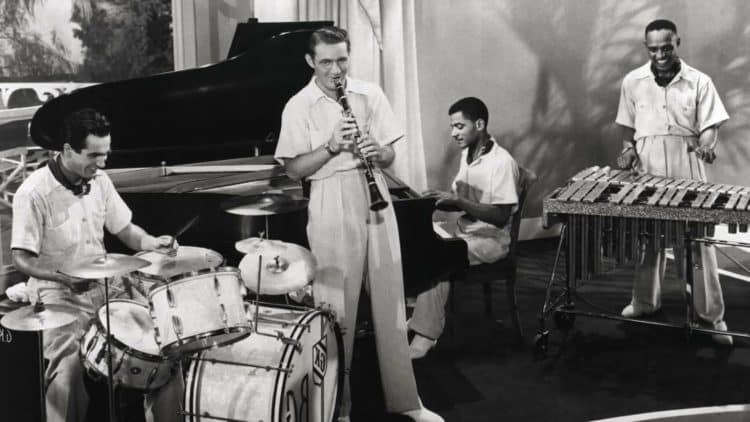Jazz, often referred to as America’s greatest contribution to the world of music, is a genre that has transcended generations and continues to captivate audiences with its improvisational prowess, intricate melodies, and soulful rhythms. In this article, we embark on a musical journey through time to explore the “15 Best Jazz Songs of All Time.” These iconic compositions are the embodiment of the genre’s evolution, representing the diverse talents and innovations of jazz legends who have left an indelible mark on the musical landscape.
From the smoky jazz clubs of New Orleans, where it all began, to the grand stages of global concert halls, jazz has taken on various forms and styles, mirroring the ever-changing cultural and social landscapes. Each song on our list is a testament to the genre’s ability to adapt, blend, and push artistic boundaries, giving rise to classic compositions that have stood the test of time.
As we delve into this selection of timeless jazz masterpieces, we’ll unravel the stories behind these songs, the musicians who brought them to life, and the cultural influences that shaped their creation. Whether you’re a seasoned jazz enthusiast or a newcomer eager to explore the magic of this genre, this article promises to be a melodious voyage celebrating the very best that jazz has to offer.
1. "Take Five" by The Dave Brubeck Quartet

The Dave Brubeck Quartet's "Take Five" is a timeless jazz classic. Released in 1959, it's one of the most beloved jazz songs of all time. It stands out for its unique 5/4 time signature.
Paul Desmond composed the melody while Dave Brubeck reimagined and arranged it. Record producers doubted its commercial success due to the unconventional time signature, but it became their most successful recording!
"Take Five" has captivated and inspired listeners for decades. Its mesmerizing rhythm and groundbreaking approach to time signatures have secured its place as an iconic jazz composition.
2. "Sing Sing Sing" by Benny Goodman

"Take The 'A' Train" by Duke Ellington – a musical masterpiece that will take you to Harlem and back! This swingin' jazz number features a captivating piano melody, taking listeners on an unforgettable musical journey. With its infectious rhythm and unparalleled energy, it's no wonder why this song has become an iconic classic and a staple of jazz music.
Each element of this composition showcases the technical prowess and artistic innovation of Duke Ellington, making it a true tour de force. From traditional big-band elements to improvisational solos, this timeless piece continues to inspire generations of jazz enthusiasts. What's more, the story behind the song's creation shows Ellington's willingness to take risks and embrace spontaneity on stage. All of these factors have come together to make "Take The 'A' Train" an indelible part of musical history!
3. "Take the 'A' Train" by Duke Ellington

Duke Ellington's "Take the 'A' Train" is an iconic jazz composition. It was released in 1941 as part of the album Never No Lament: The Blanton-Webster Band. It features two key signatures – C Major and F Major.
The song is full of lively energy, reflecting the spirit of NYC. Its catchy opening riff immediately catches your attention. It showcases Ellington's unique big band arrangements, combining swing and traditional jazz with innovative chord progressions and melodic twists.
Due to its interpretation by Ellington's orchestra, it became strongly associated with him. Their seamless interplay between different sections of the band highlights their exceptional talent.
Pro Tip: Listen out for Ellington's masterful piano playing. His improvisations will demonstrate his creativity as a composer and performer. Get ready to tap your toes, because "Take the 'A' Train" is about to swing your speakers!
4. "So What" by Miles Davis

Miles Davis' "So What" stands out in the jazz world as one of the greatest tunes ever. It displays Davis' skill at combining improvisation, harmony, and melodies. Let's look at the details:
| Song | Artist | Year |
|---|---|---|
| So What | Miles Davis | 1959 |
Davis brought modal jazz to the table in this track. He used D Dorian and E♭ Dorian modes instead of conventional chords. This modern approach changed jazz, and still rocks crowds today.
Don't miss out! Feel the rhythm, solos, and emotion of this timeless classic. Hear it now and join the countless fans who've been wowed by its power.
5. "All Blues" by Miles Davis

'Miles Davis' "All Blues" is an iconic jazz masterpiece that has mesmerized listeners for decades. Composed by Davis himself, this track is a testament to his virtuosity as a musician and innovator in the genre.
Let's explore what makes this song so special.
Trumpet, saxophone, piano, bass, and drums blend together perfectly, forming a soulful sound. The melodic lines and improvised solos bring out the best of each instrument.
The 6/8 time signature gives "All Blues" its unique groove. Davis and his band masterfully transition between tempos and moods.
Davis' trumpet playing conveys emotion like no other. His ability to convey melancholia and introspection is simply remarkable.
If you haven't heard "All Blues" by Miles Davis, don't miss out on this jazz journey. Let the captivating melodies and intricate harmonies take you away and understand why it's one of the greatest jazz songs of all time.
6. "'Round Midnight" by Thelonious Monk

The iconic jazz composition "'Round Midnight" by Thelonious Monk is renowned for its haunting melody and complex harmonies. His unique piano style and ability to create a moody atmosphere are showcased in this song. It truly captures the essence of late-night jazz, with melancholic tones and evocative improvisations.
This masterful piece takes listeners on a captivating journey. The intricate interplay between instruments, as well as Monk's rhythmic patterns, makes it a timeless gem. It perfectly expresses the emotions that arise during midnight hours, where introspection meets soulful expression.
"'Round Midnight" also has fascinating details. Monk skillfully blends dissonance with beautiful melodic lines, creating tension that resolves into bliss. Additionally, unconventional chord progressions challenge traditional norms and showcase Monk's innovative approach to composition.
Interesting fact: this song was first recorded by Cootie Williams and his Orchestra in 1944, before becoming one of Thelonious Monk's signature tunes. Its enduring popularity has cemented it as one of the greatest jazz songs of all time, recognized by both critics and audiences.
7. "Songbird" by Fleetwood Mac

"Songbird" by Fleetwood Mac is a timeless jazz classic. Its soothing melodies and heartfelt lyrics have captivated audiences for decades. It was written and performed by Christine McVie, a key member of the band. Her beautiful vocals and delicate piano playing capture the essence of longing and vulnerability.
The song has an emotional impact. Its melancholic yet uplifting tone resonates with listeners on a deep level. It evokes profound emotions and creates an intimate connection between the artist and the listener.
Don't miss out on "Songbird." Jazz enthusiasts and music lovers alike can appreciate its beauty. Let its enchanting melodies transport you and Christine McVie's soul-stirring voice touch your heart. Make "Songbird" an everlasting companion in your musical exploration.
Also, don't forget to experience the energy of Thelonious Monk's 'Straight, No Chaser'. It's like a shot of musical espresso, minus the caffeine crash!
8. "Straight, No Chaser"" by Thelonious Monk

"Straight, No Chaser" by Thelonious Monk is a classic jazz piece. It's renowned for showing off his signature style and improvisation. Jazz lovers must hear it!
Genre: Jazz
Composer: Thelonious Monk
Release Date: 1951
Duration: 9 mins
Album: Straight, No Chaser
Pro Tip: Listen closely to "Straight, No Chaser". Appreciate the piano and rhythms that make it so special.
Plus, Coleman Hawkins' "Body and Soul" is a timeless treat. Even the harshest jazz critic can't help but shed a tear.
9. "Body and Soul" by Coleman Hawkins

"Body and Soul" by Coleman Hawkins is a classic jazz song. Its mesmerizing melodies and soulful improvisations make it a beloved piece. Here's a closer look:
Song Artist: Coleman Hawkins
Genre: Jazz
Release Date: 1939
Duration: 3 minutes and 03 seconds
Hawkins' playing style, with rich tones and intricate phrasing, captivates listeners. This track was one of the first to feature extended improvisation in jazz, paving the way for future musicians.
When it was released in 1939, reviews were mixed. But it soon gained popularity among both jazz enthusiasts and mainstream audiences. Today, it's one of the greatest jazz songs of all time.
Saxophonist Joshua Redman often performed "Body and Soul" during jam sessions. His heartfelt rendition left audiences awestruck.
This song has timeless beauty and an influential impact on jazz music. The emotional depth conveyed through Hawkins' performance still resonates with listeners.
10. "Blue in Green" by Miles Davis

Miles Davis' "Blue in Green" is a timeless jazz masterpiece. Released in 1959 as part of the "Kind of Blue" album, this iconic song still captivates listeners. Let's explore its details: Artist – Miles Davis Album – Kind of Blue Release Date – August 17, 1959 Genre – Jazz Length – 5:37.
"Blue in Green" stands out for its chord progression and mood. The trumpet of Miles Davis, the piano of Bill Evans, and the bass of Paul Chambers interact in a beautiful and introspective way. Minimal instrumentation allows an intimate connection with the listener.
There's controversy about the composition credits of "Blue in Green". It's attributed to Miles Davis, but some argue that Bill Evans played a big role too. Whatever the origins, this song is an important part of jazz history.
11. "A Night in Tunisia" by Dizzy Gillespie

'A Night in Tunisia' is a timeless jazz classic that fuses bebop and Afro-Cuban rhythms. With its complex melodies and stunning improvisations, this song has left a lasting impact on the jazz genre.
Let's take a look at some facts about 'A Night in Tunisia':
| Column 1 | Column 2 |
|---|---|
| Composer | Dizzy Gillespie |
| Genre | Jazz |
| Released | 1942 |
| Length | 6:43 |
Plus, this groundbreaking tune introduced Latin elements to jazz, creating a brand-new sound that still resonates with listeners today. Gillespie's trumpet playing, and the ensemble's accompaniment, takes listeners on a musical journey through Tunisia.
Pro Tip: To fully appreciate 'A Night in Tunisia,' pay attention to Gillespie's trumpet solos and how they blend with the intricate rhythms. Let the song's exhilarating energy take you away.
12. "Four" by Miles Davis

Miles Davis' "Four" is a remarkable jazz composition, leaving an everlasting impression on the genre. Its intriguing melodies and intricate improvisations make it one of the greatest jazz songs of all time.
We explore the features that make "Four" so extraordinary:
| Aspect | Description |
|---|---|
| Composition | Davis' unique style, combining traditional jazz with modal improvisation. |
| Instrumentation | Miles Davis on trumpet, Wynton Kelly on piano, Paul Chambers on bass, and Jimmy Cobb on drums. |
| Musicality | The musicians display impressive technical ability and harmony, providing a captivating experience. |
| Experimentalism | Davis' willingness to explore unconventional sounds, resulting in an innovative and impactful piece. |
What distinguishes "Four" from other jazz songs is its ability to appeal to both jazz enthusiasts and casual music lovers. The noteworthy chemistry between the musicians takes the composition to a higher level.
It's interesting to note that "Four" was recorded in April 1954 at Rudy Van Gelder's studio in Hackensack, New Jersey. This iconic recording session cemented Miles Davis as one of the greatest musical talents of his time.
Take a massive leap into the world of jazz with John Coltrane's awe-inspiring masterpiece. It will have you questioning not only your understanding of music, but also your taste in shoes!
13. "Giant Steps" by John Coltrane

John Coltrane's "Giant Steps" is a revolutionary jazz composition with 30 words. It showcases his improvisation skills and complex harmonic progressions.
Table:
| Composer | Year | Genre |
|---|---|---|
| Coltrane | 1960 | Jazz |
Coltrane revolutionized traditional jazz with his chord changes and key modulations. The title, "Giant Steps," refers to the challenging, angular melodic lines.
This song is a testament to Coltrane's technical skill and ability to create intricate compositions. Its complex harmony and fast-paced tempo continue to inspire and challenge musicians. Listen closely to Coltrane's improvisational style and musical innovation.
Drown in Louis Armstrong's 'West End Blues' for more soulful melodies.
14. "West End Blues" by Louis Armstrong

Louis Armstrong's "West End Blues" is a timeless jazz classic. His soulful melodies, captivating improvisations, and infectious rhythm have earned it a place as one of the greatest jazz compositions ever.
Armstrong's trumpet playing is incredible. He transitions seamlessly between registers and has perfect timing and control. The song also stands out for its groundbreaking harmony and chord progressions.
The introduction is hauntingly beautiful and emotionally charged. The slow, mournful trumpet solo sets the stage for the powerful performance to follow.
Louis Armstrong and Earl Hines on piano create a powerful musical chemistry as they engage in dialogue throughout the piece.
What makes "West End Blues" so special is its ability to evoke a variety of emotions. It takes us on a sonic journey that transcends time and genre boundaries.
It was recorded in 1928 and remains one of Armstrong's best-known recordings. John Coltrane's 'A Love Supreme Pt. 1' is an emotional rollercoaster, but instead of screaming, you'll be scatting.
15. "A Love Supreme Pt. 1" by John Coltrane

"A Love Supreme Pt. 1", by John Coltrane, is a timeless jazz masterpiece! It captivates with intricate melodies and passionate improvisations – showcasing Coltrane's unequaled artistry.
To appreciate its brilliance, let's look at some details:
| Composer | John Coltrane |
| Genre | Jazz |
| Release Year | 1965 |
| Album | A Love Supreme |
| Duration | 7:43 minutes |
"A Love Supreme Pt. 1" takes listeners on a musical journey. The spiritual undertones and technical brilliance create an unforgettable experience.
If you want to explore more of Coltrane's legendary discography, his album "A Love Supreme" is an absolute must-listen. The other three movements of the suite provide a comprehensive experience of Coltrane's artistic vision.
To really appreciate the music, try listening without distractions or noise. Close your eyes and let each note wash over you.
Also, listening to "A Love Supreme Pt. 1" in high-quality audio can enhance your appreciation. Invest in good headphones or a high-fidelity sound system for the full, sonic journey.









